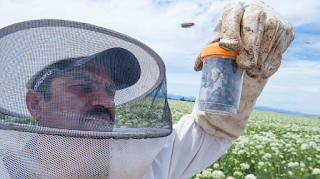Unraveling the Mystery Behind Honeybee Decline: A West Coast Initiative
In a crucial effort to decipher the enigma surrounding the resurgence of European foulbrood disease in honeybee hives, researchers from the West Coast are embarking on a comprehensive study. The spotlight is on over 1,500 honeybee hives across California, Oregon, and Washington, where a bacterial disease threatens these vital pollinators.
Why Does It Matter? While beekeepers have long been familiar with European foulbrood disease, its recent surge raises alarms for the bee-dependent crops crucial to commercial food production. Ramesh Sagili, an apiculturist and professor at Oregon State University, underscores the urgency, stating, "We know the basics, but what we don't know are the triggers."
The Intricacies of Foulbrood European foulbrood disease strikes honeybees during the larvae stage, turning eggs into a detrimental brown mush. The infection spreads easily, hindering the hive's replenishment and leading to its demise. The concern deepens as infected bees move through the colonies, potentially affecting the entire population.
The Research Initiative Oregon State University, backed by a $4.2 million grant from the U.S. Department of Agriculture, is leading a four-year study. Collaborating with Washington State University and the University of California, Davis, researchers will explore stress factors contributing to bee susceptibility. This includes investigating malnutrition, climate conditions, and the impact of pollination practices.
Connecting the Dots Preliminary findings suggest a correlation between the spread of foulbrood and the pollination process. Commercial beekeepers returning to their home states after pollinating orchards in California notice a higher incidence of disease in hives involved in blueberry pollination. Oregon and Washington, major blueberry producers, witness blooming in cold and rainy conditions, potentially compromising bees' immune systems due to nutritional stress.
The Impact As foulbrood continues to spread, hives weaken, and bees struggle to pollinate vast acres essential for regional food supplies. This study aims not only to understand the disease but also to formulate strategies to safeguard honeybee populations and ensure the stability of our food sources.
In Conclusion The West Coast initiative is a beacon of hope in the battle against honeybee decline. By unraveling the complexities of European foulbrood disease, researchers strive to pave the way for sustainable pollination practices, securing the future of our environment and food supply.
Frequently Asked Questions (FAQ):
What is European foulbrood disease?
- European foulbrood is a bacterial disease affecting honeybees, particularly during the larvae stage, leading to a decline in bee populations.
Why is the resurgence of foulbrood concerning?
- The rapid resurgence of foulbrood raises concerns about its potential impact on commercial food production, as bee-dependent crops face a threat.
What is the focus of the West Coast study?
- The study aims to identify stress factors, including malnutrition and climate conditions, contributing to bee susceptibility to foulbrood.
How long will the research initiative last?
- The project, led by Oregon State University, spans four years, with a comprehensive approach to understanding and combating foulbrood.
What are the potential correlations between pollination and foulbrood?
- Preliminary findings suggest a correlation between blueberry pollination, adverse weather conditions, and the increased incidence of foulbrood in honeybee hives.
- #BeeHealth, #EnvironmentalResearch, #PollinatorDecline, #HoneybeeStudy, #ClimateImpact

